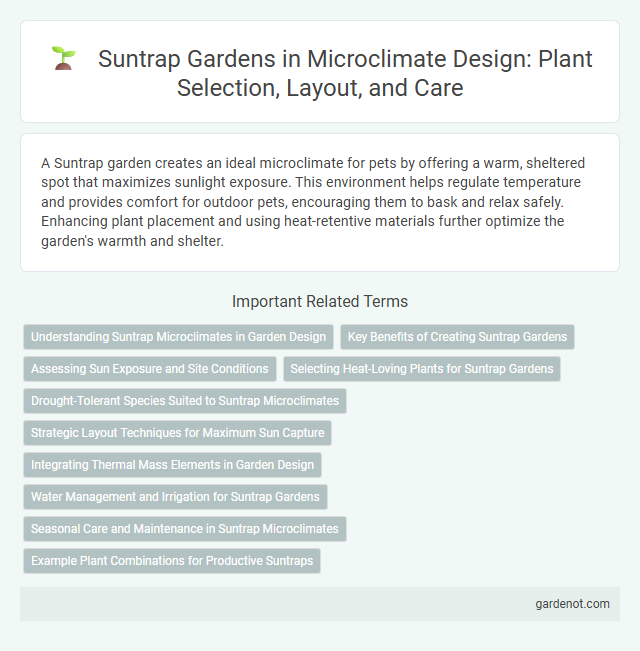A Suntrap garden creates an ideal microclimate for pets by offering a warm, sheltered spot that maximizes sunlight exposure. This environment helps regulate temperature and provides comfort for outdoor pets, encouraging them to bask and relax safely. Enhancing plant placement and using heat-retentive materials further optimize the garden's warmth and shelter.
Understanding Suntrap Microclimates in Garden Design
Suntrap gardens create localized microclimates characterized by warmer temperatures and reduced wind exposure, ideal for cultivating heat-loving plants in cooler regions. Utilizing south-facing walls, sheltered courtyards, and reflective surfaces maximizes solar gain, promoting enhanced photosynthesis and extended growing seasons. Careful placement of plant species within these suntrap zones optimizes moisture retention and reduces frost risk, contributing to sustainable and resilient garden ecosystems.
Key Benefits of Creating Suntrap Gardens
Suntrap gardens maximize solar exposure, creating warm microclimates that extend growing seasons and support diverse plant species, including those requiring higher temperatures. They enhance plant health by reducing frost risk and improving soil warmth, leading to increased yields and vibrant blooms. These gardens also provide energy savings by naturally moderating temperatures around homes and outdoor spaces.
Assessing Sun Exposure and Site Conditions
Assessing sun exposure and site conditions in a Suntrap garden involves measuring the duration and intensity of sunlight throughout the day to identify optimal planting zones. Soil temperature, moisture levels, and wind protection are critical factors that influence microclimate stability and plant health. Accurate evaluation of these elements ensures the creation of a warm, sheltered environment that maximizes solar gain and supports diverse, sun-loving plant species.
Selecting Heat-Loving Plants for Suntrap Gardens
Suntrap gardens thrive by selecting heat-loving plants such as lavender, rosemary, and agave that maximize warmth and sunlight exposure. These species retain moisture effectively and tolerate high temperatures, creating a vibrant microclimate ideal for Mediterranean and desert flora. Integrating drought-resistant succulents and sun-adapted perennials enhances garden sustainability while boosting photosynthesis efficiency in suntrap environments.
Drought-Tolerant Species Suited to Suntrap Microclimates
Drought-tolerant species such as lavender, sedum, and agave thrive in suntrap microclimates by efficiently conserving water and withstanding intense sunlight. These plants feature deep root systems and waxy leaves that minimize water loss, making them ideal for dry, hot garden conditions. Incorporating these species into suntrap gardens enhances sustainability and reduces irrigation needs.
Strategic Layout Techniques for Maximum Sun Capture
Suntrap gardens utilize strategic layout techniques such as orienting plant beds toward the south and incorporating thermal mass elements like stone walls to maximize sunlight absorption. Careful placement of windbreaks and reflective surfaces enhances heat retention, creating an ideal microclimate for sun-loving plants. Optimizing sun exposure in this manner supports extended growing seasons and increased plant productivity.
Integrating Thermal Mass Elements in Garden Design
In a Suntrap garden, integrating thermal mass elements such as stone walls, concrete paths, or water features helps capture and store solar heat during the day, releasing warmth during cooler evenings to create a stable microclimate for plants. These materials absorb sunlight and moderate temperature fluctuations, enhancing plant growth by extending the growing season. Strategic placement of thermal mass elements near sensitive plants optimizes heat retention and supports biodiversity within the garden ecosystem.
Water Management and Irrigation for Suntrap Gardens
Suntrap gardens benefit from efficient water management strategies that maximize moisture retention and minimize evaporation in sheltered microclimates. Incorporating drip irrigation systems and rainwater harvesting techniques enhances precise watering, ensuring plants receive optimal hydration without waste. Mulching and soil amendments further improve soil water retention, supporting healthy plant growth within suntrap environments.
Seasonal Care and Maintenance in Suntrap Microclimates
Suntrap microclimate gardens require tailored seasonal care to optimize plant health and growth. In spring, intense sunlight demands regular watering and mulching to retain soil moisture, while summer necessitates shading and frequent irrigation to prevent heat stress. Autumn brings the need for leaf clearance and soil enrichment, ensuring plants remain vigorous through winter dormancy.
Example Plant Combinations for Productive Suntraps
Ideal plant combinations for productive suntrap gardens include heat-tolerant species like tomatoes, basil, and peppers, which thrive in abundant sunlight and warm microclimates. Companion planting with marigolds or nasturtiums helps deter pests while enhancing soil health. Integrating drought-resistant herbs such as rosemary and thyme maximizes water efficiency and supports continuous growth in sun-exposed areas.
Suntrap garden Infographic

 gardenot.com
gardenot.com